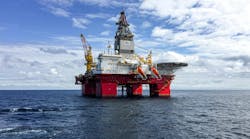$470 million targeted for Tabasco Littoral exploration
David ShieldsActivity is heating up and production is rising in the shallow waters of Mexico's offshore Campeche Bay area. This is the result of recently-approved budgetary increases for government-owned Petroleos Mexicanos's (Pemex) exploration and production division.
Contributing Editor - Mexico
Much of the work, which is likely to maintain its upswing from now until at least the end of the century, will benefit private firms through public tenders for oilfield service jobs. These tenders are being published at an ever-faster rate.
The total budget for exploration and production will be the peso-equivalent of $4.07 billion dollars this year, up 7% from last year's $2.39 billion. The main objective will be to increase Mexican oil production to almost 3,100,000 b/d by end-l997, up from an average of 2,858,000 b/d in 1996. Of that amount, roughly 75% is to come from Mexico's single offshore province in the Bay of Campeche.
Investment in offshore work had been depressed over the past two years due to Mexico's 1995 financial crisis and other political considerations related to the change in government at the end of 1994. Problems now have been overcome and oil-related work is gaining momentum.
When participating in major public tenders, private firms will be expected to provide project financing for the work they do for Pemex. This will apply in so-called strategic projects, which are those expected to be highly profitable upon completion. For instance, service work leading to greater short-term oil and gas output will soon pay for itself and this is the basic guarantee being offered by Pemex to contractors who provide financing.
Major project financing will focus on two strategic projects:
- The Cantarell field development project, estimated to required $1 billion in total investment.
- Drilling work on fields in the recently-discovered Tabasco Littoral, estimated to need about $470 million.
Cantarell project
The Cantarell project is Pemex's most important strategic objective and is at the heart of short term efforts to increase oil output. The project is earmarked $5 billion dollars in investments over five years.Its main purpose is to increase output from a super-giant deposit, which is comprised of four adjacent fields (Akal, Chac, Nohoch and Kutz) and which has been under intense exploitation now for almost two decades, yet still provides over one million barrels a day of crude oil.
The Cantarell complex accounts for half of Mexico's offshore crude oil output and 72% of its proven offshore hydrocarbon reserves. Cantarell lies below about 120 ft of water in the Bay of Campeche and provides heavy crude at about 22 degree gravity API.
Over the next four years, 164 new wells are to be drilled and 18 platforms are to be installed on the complex. Bechtel is to be Pemex's general administrator of operations on the project. In December 1996, a public tender open to Mexican companies only was published for construction and installation of seven of the platforms. The other 11 platforms will be tendered over the next three years. A specific objective is to reactivate work at platform construction companies and in the steel industry in the states of Veracruz and Tamaulipas on Mexico's Gulf Coast.
On May 15, it was officially announced that Mexican construction firm ICA won the public tender for construction and installment of two octapode offshore platforms, called Akal-BN and Akal-DB, on the Cantarell offshore oil field. These two projects will be worth $45 million in all. Work is to begin at once, will require 13 months to complete, and will be financed by ICA. Bufete Industrial, another leading Mexican construction firm, won a contract for a similar platform.
Numerical models which simulate field behavior have been used to determine the exact location of each of the new wells to be drilled, according to Pemex. Between July and October of last year, 3-D seismic studies were carried out. Careful, balanced spacing between the wells will be a priority. Pemex maintains that the faster drilling and production rate will not have a significant effect on long-term oil recovery levels. This, however, is disputed by some ex-Pemex engineers, who say the drilling of so many intermediate wells may reduce well pressure or even cause some damage to the field in the medium term.
The Cantarell project will also involve installation of compressors and pumping equipment, gas dehydration plants, fluid-separation plants, water-treatment facilities, automatic monitoring, digital control systems, and the construction of the world's biggest nitrogen-production facility.
Nitrogen injection
An international public tender was published in February to build and operate a nitrogen generation plant which will produce 1.5 billion cu ft/day for the Cantarell project. The facility is to be built on the nearby Atasta peninsula and the nitrogen will be pumped into the field over a period of 15 years in order to maintain well pressure. The nitrogen injection project is unprecedented anywhere in the world, just as the Cantarell complex is a very unique group of hydrocarbon deposits.The nitrogen facility, without doubt, is the most controversial aspect of the Cantarell project, since such vast volumes of nitrogen have never been pumped into an oil field anywhere in the world. There is some concern about how the nitrogen will impact rock surfaces in such a highly fractured group of oil deposits and how it might affect the calorific value of the deposit's vast natural gas reserves. However, Pemex assures it has done its homework on the subject.
In the short term, Pemex is working fast to increase surface infrastructure, particularly pipelines, to take the increased output from Cantarell. Production from Cantarell is expected to jump from 1,064,000 b/d in 1996 to 1,223,000 b/d in 1997. Until the nitrogen project is ready, which may be as many as three years away, natural gas will be pumped back into the field to maintain pressure. This will also allow Pemex to reduce the amount of gas being freed into the atmosphere from the field, while new gas pipelines come ready.
Tabasco Littoral work
The Tabasco Littoral project will involve exploratory and development drilling in up to ten relatively small fields, with very light crudes (about 47 degree gravity API) and a high gas-to-oil ratio, both onshore and offshore, near the Tabasco coastline.
The fields lie close to existing oil and gas collection infrastructure, taking production onshore at Dos Bocas, Tabasco, from where it can either be exported or transported and processed.
Several tenders published early in the year reveal that Pemex is seeking the help of private firms to carry out geophysical work and measure output from exploratory wells on the Tabasco Littoral, plus providing drill-bit services for these wells.
Pemex has been working on financing schemes for the Cantarell and Tabasco Littoral projects. Credits from US, Japanese, Canadian and European development banks are likely to be sought. Commercial bank loans, plus asset financing mechanisms and capital-market financing, are also expected to provide considerable amounts of money for the projects.
Other plans
Other offshore projects are also starting up:- In May, a tender was published for 3D-seismic work to be carried out on the Ku-Zaap-Maloob complex, which consists of a number of very heavy (12 degree gravity API) crude oil fields. It lies in slightly deeper waters just north-east of Cantarell. Some tenders for drilling, both on Zaap and Akal, have been published recently. An integral service contract has also just been announced for the drilling of three horizontal development wells using jack-ups on the Pol field, which, together with adjacent Abkatun and Chuc fields, forms Mexico's biggest offshore light crude oil complex. Contracts for drilling new wells on Chuc have also been announced.
- Later in the year, tenders are expected for six major offshore pipelines in Campeche Bay, one for oil, two for gas, and three to carry both oil and gas. These include a 48-mile, 36-in. diameter oil pipeline which will carry light crude from Abkatun, Chuc and Caan fields to collection and compression facilities at Dos Bocas. The cost of this pipeline is estimated at $120 million dollars.
- Building of a compression platform to handle 330 MMcf/d of gas in the southeastern part of the Campeche offshore region is also to be competed by private firms. Contractors can expect work worth $112 million dollars on that job.
- Exploratory drilling has begun in a nearby shallow-water area, just off the coast from Coatzacoalcos, Veracruz. 3D-seismic was carried out, apparently with very successful results, by Western Atlas in the area in 1995.
- Contracts of all kinds are beginning to be awarded to private firms for services. In May, a $176-million dollar contract for three offshore wells using a jackup went to Mexican firm Perforadora de Campeche. A $29-million dollar contract for turbocompressors and turbopumps went to Solar Turbines Inc. A $4.9-million dollar contract for drilling accessories went to Halliburton, Owen Oil Tools, and Schlumberger Offshore Services.
Pemex's position
Pemex 's exploration and production division reported first-quarter 1997 operating income of $5.22 billion dollars, reflecting as usual the division's big revenues from production, sales and exports of oil and gas. It was a 34% increase from first-quarter 1996 income.Higher profits at the division were due to higher world oil prices and higher output of crude oil and natural gas. Crude oil output stood at 2,958,000 barrels per day (b/d), an increase of 122,000 b/d, or 4.3%, from first-quarter 1996. Offshore oil production was 2,228,000 b/d, up from 2,106,000 b/d in the first quarter of 1996.
Reserves lowered
A curious twist to current offshore work is that Pemex recently released new official figures of its proven offshore hydrocarbon reserves, which admit that these were previously exaggerated. Pemex had long been accused of overstating its reserve figures.The new figure of total offshore reserves stands at 17.1 billion bbl of hydrocarbons, which contrasts with the previous official figure of 33.5 billion bbl for the offshore Campeche region. Of the 17.1 billion bbl, 12.3 billion correspond to the Cantarell complex.
Analysts say that the new figure implies, in practice, that overall Mexican proven reserves are being revised downward by 30-40%. The company had been pressured into revising its figures by ex-Pemex engineers and claiming that the reserves were greatly inflated.
Outside of Mexico, the new reserve figures have led to some speculation that Pemex will now have to increase efforts and expenditures for exploration, perhaps opening up these activities to foreign firms. Mexican officials deny this possibility and say there will be no openings to foreign companies, except in oilfield services, which excludes the right to produce oil.
Indeed, when Pemex has private companies compete for integral drilling jobs, the tenders specifically say that the work to be undertaken by the private operators does not commit either Mexico's hydrocarbon strategies or Pemex's information about the resources. Pemex, according to the tenders, will define the place, the method, and the objective of the drilling work and will be responsible for interpreting the geological and geophysical information obtained.
Looking ahead
Mexico's current policy concentrates on increasing production from existing fields and little work is ongoing in exploration. However, only one offshore province is being exploited and in that province there is heavy reliance on one single group of fields (the Cantarell complex). Some of the other major fields in the area, such as Abkatun and Ek-Balam, have been presenting problems and output from them has fallen over the past two years. Meanwhile, no exploration has yet been carried out in deeper waters, where Mexico's greatest offshore potential is thought to lie.Most investment at Pemex is currently going into mature fields, rather than into exploration and development of new deposits, both onshore and offshore. Although there is undoubtedly still much to be obtained from these fields, observers note that such investment can in no way provide vast profit margins, such as those obtained in the early 1980s, when giant virgin offshore fields were discovered.
Also, Mexico is accustomed to exploiting oil from one supergiant and several large-to-giant-sized fields. Sooner or later, these fields will have to be replaced by other large discoveries, if Mexico hopes to maintain oil production near its current levels.
That is making many Pemex officials think that the Mexican oil industry will have to start exploring in virgin areas soon, giving special priority to deeper waters, where Pemex does not yet have any real experience.
Copyright 1997 Oil & Gas Journal. All Rights Reserved.




